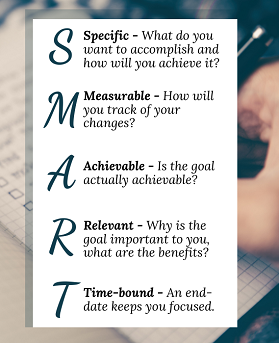
How many times have you set a goal, only to find that before too long it’s gone out the window?
Well, you’re not alone.
? So how do you stick to your making your goals happen then? Can it be done?
How many times have you set a goal, only to find that before too long it’s gone out the window?
Well, you’re not alone.
One reason for why this happens is that the goal is a bit vague.
"I'm going to eat healthy and exercise more."
It doesn't take long for that sort of goal to get lost in everyday things – work, school, chores... etc.
? So how do you stick to your making your goals happen then? Can it be done?
? Yes, but you have to make your goals realistic and have a plan to make it happen.
A good way to set goals is to use the SMART framework:

? Specific – What do you want to accomplish and what will you do to achieve it?
? Measureable – How will you track of your changes?
? Achievable – Is the goal actually achievable? Yes, it is great to challenge yourself, but not so much that you feel overwhelmed and give up.
? Relevant – Why is the goal important to you? What are the benefits of achieving it? Make your goal meaningful.
? Time-bound – what is your goal time-frame? An end-date helps to provide motivation and keeps you focused.
If you haven’t achieved your goal in the timeframe, take time to consider why.
Maybe it was unrealistic or your goal was unachievable, or maybe there were some unexpected barriers that got in your way.
The SMART framework allows you to set boundaries and defines the steps that you’ll need to take. It will also allow you to see what resources or support you might need to help you to reach your goal. Maybe you need a nutritionist to help you tweak your diet or an exercise partner to help keep you motivated.
Some examples of SMART goals are:
✔️“eat healthy” becomes “I will add one extra serve of green vegetables to dinner three times this week.”
✔️“buy lunch less often” becomes “I will pack my lunch 2 times this week.”
✔️ “exercise more” becomes “walk with a friend, after work for 20 minutes three times a week.”
Once you achieve your initial goals you can build on your successes and alter your goals accordingly.
E.g. if you successfully added green vegetables 3 times in a week, increase it to 5 or even 7 times.
When setting your SMART goals, focus on positive actions rather than looking to what you should avoid or limit. Look to where you can add in healthy foods or more movement, rather than putting the focus on what you should take out.
If you have set yourself the general “eat healthy and exercise more” resolution, maybe you can have a go at SMARTening it up.
Or if you need help to define and achieve any nutrition or dietary goals please send Nicole a message... I'm here to help! ?
Download my "Setting SMART Goals Guide" to get you started on making goals that you can achieve.
$FREE ~ Download now
When you buy or download a product you will be added to my newsletter mailing list, you may unsubscribe at any time.
Refund Policy: Due to the digital nature of these products, refunds are not eligible.
